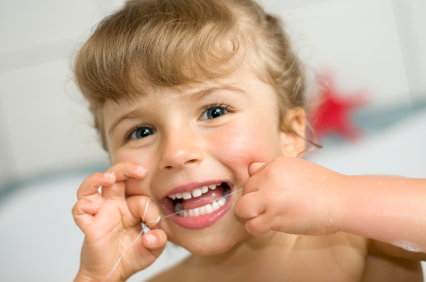When Should Kids Start Cleaning Their Teeth?
We believe that all children should enjoy good dental health and have access to quality children’s dentistry. Children’s dental health begins with a great (daily!) home care routine.
When should families start cleaning their child’s teeth? And when can they expect a child to be capable of cleaning their teeth on their own?
Dental Care Starts Early
The care of your baby’s teeth should begin as soon as their teeth emerge. That’s because bacteria can cause tooth decay at any age.
Begin With Cleaning Baby’s Gums…
Even before teeth appear, you can introduce the concept of cleaning by gently using a soft, damp cloth twice a day on your baby’s gums.
Once teeth appear, introduce a super-soft baby’s toothbrush. Toothpaste isn’t necessary: simply use the bristles to brush away food particles and plaque gently. It’s easier to do this with your child lying down with their head in your lap.
Introduce Toothpaste at 18 Months
At the age of 18 months, child-strength fluoride toothpaste can be introduced. Small children only need a tiny amount of toothpaste on their brush, about the size of a grain of rice.
Children of this age often can’t personally clean their teeth well, and assistance is required from parents and caregivers to brush their teeth and gums thoroughly. Use soft pressure and gentle circular movements, concentrating the bristles on the teeth angled near the gums.
Continue to use child-strength fluoride toothpaste until your child is six years old or until a dentist recommends a change.
The video below is by the Australian Dental Association. It explains how to take care of your young child’s teeth.
Supervise Your Child As They Brush
Until a child is able to brush their own teeth thoroughly, an adult should be available to assist, supervise, and encourage. It’s particularly important to make sure your child is:
- Using the right amount of toothpaste (a small pea-sized blob of the appropriate-strength toothpaste for their age)
- Brushing each tooth thoroughly: the outer, inner, and chewing surfaces of each tooth need attention
- Spitting the toothpaste out (it is not necessary to rinse their mouth out after brushing)
- Cleaning up by rinsing their toothbrush and storing it properly, and replacing the cap on the toothpaste.
Please feel free to ask Dr Teo about plaque-disclosing agents as a way of checking how well your child is cleaning their teeth.
Encourage Your Child to Brush
Parents often have to be creative to encourage children to brush.
Use a Timer
Some children are quite happy to brush whilst watching a timer count down two minutes; others find this isn’t enough to hold their attention.
Sing As You Brush
One way to turn the task of brushing into a fun one is to have children brush along to a favourite song or piece of music. This can be done in many ways:
- The song can be sung in their head
- An adult or sibling can hum or sing while the child brushes
Play a Song on Your Device
Select a song that has a two-minute playing time, and get the kids to brush along. Help them to develop a toothbrushing ‘dance’: “We’ll clean the top right first, the lower right next, and spend the chorus doing the insides.” Participating in a choreographed brushing dance can be great fun!
Play a Toothbrushing Video
If your young child is more visual, try playing the Sesame Street video “Brushy Brush”.
- Playing time – 00:01:30
Videos About Toothbrushing for Children
This video is from the American Dental Association. It’s about how to teach a child to brush their teeth.
- Playing time – 00:02:13
And this video from the Vancouver Coastal Health Children’s Dental Department demonstrates the knee-to-knee technique for brushing very young children’s teeth.
- Playing time – 00:05:31
When Should Kids Start Flossing?

Flossing teeth is a habit not just for adults; kids also benefit from regular flossing. But when should kids start flossing?
As soon as your child’s teeth start to touch, it is time to floss their teeth.
At first, you’ll need to floss your child’s teeth yourself as it may take years before children have the dexterity to manage it themselves.
How to Floss a Child’s Teeth
To floss your small child’s teeth, it’s easiest to have them lying down with their head in your lap. Use the floss to remove food and plaque from the gaps where teeth touch together. Be careful not to force the floss into their gums; gently slide the floss down the sides of each tooth. Use good lighting so that you can see what you’re doing, and let your child use a mirror to watch.
You can floss an older child’s teeth with them standing in front of you: simply have them tilt their head back with their mouth open so that you can see their teeth.
When you first teach a child to floss their own teeth, they can use floss around their fingers or floss holders. Please feel free to ask Dr Teo for personalised recommendations. She has an assortment of flossing apparatuses available for you and your child to try.
If a child learns from a young age that flossing is just part of the routine of keeping their teeth clean, they are much more likely to continue to floss throughout their life.
Watch this Video: Kids and Flossing
- Running time – 00:02:07
Establish the Twice-Daily Tooth-Cleaning Habit in the Early Years
Let your children see that twice-daily dental care is part of your own routine. Allow them to watch you brush and floss your own teeth and watch other children clean theirs.
The sooner a child understands that teeth cleaning is an important part of self-care, the more likely they are to value the task and to do it themselves willingly.
